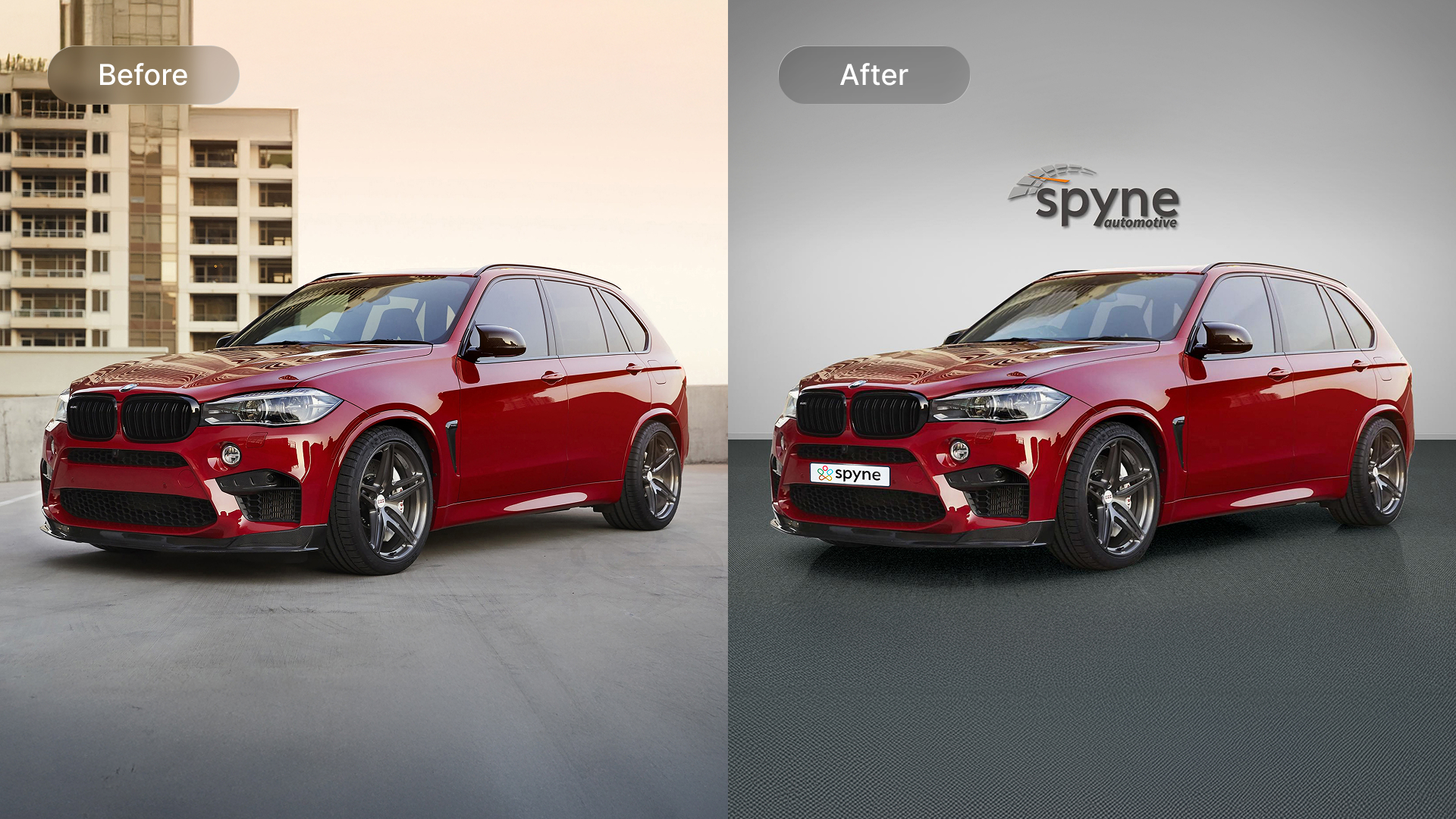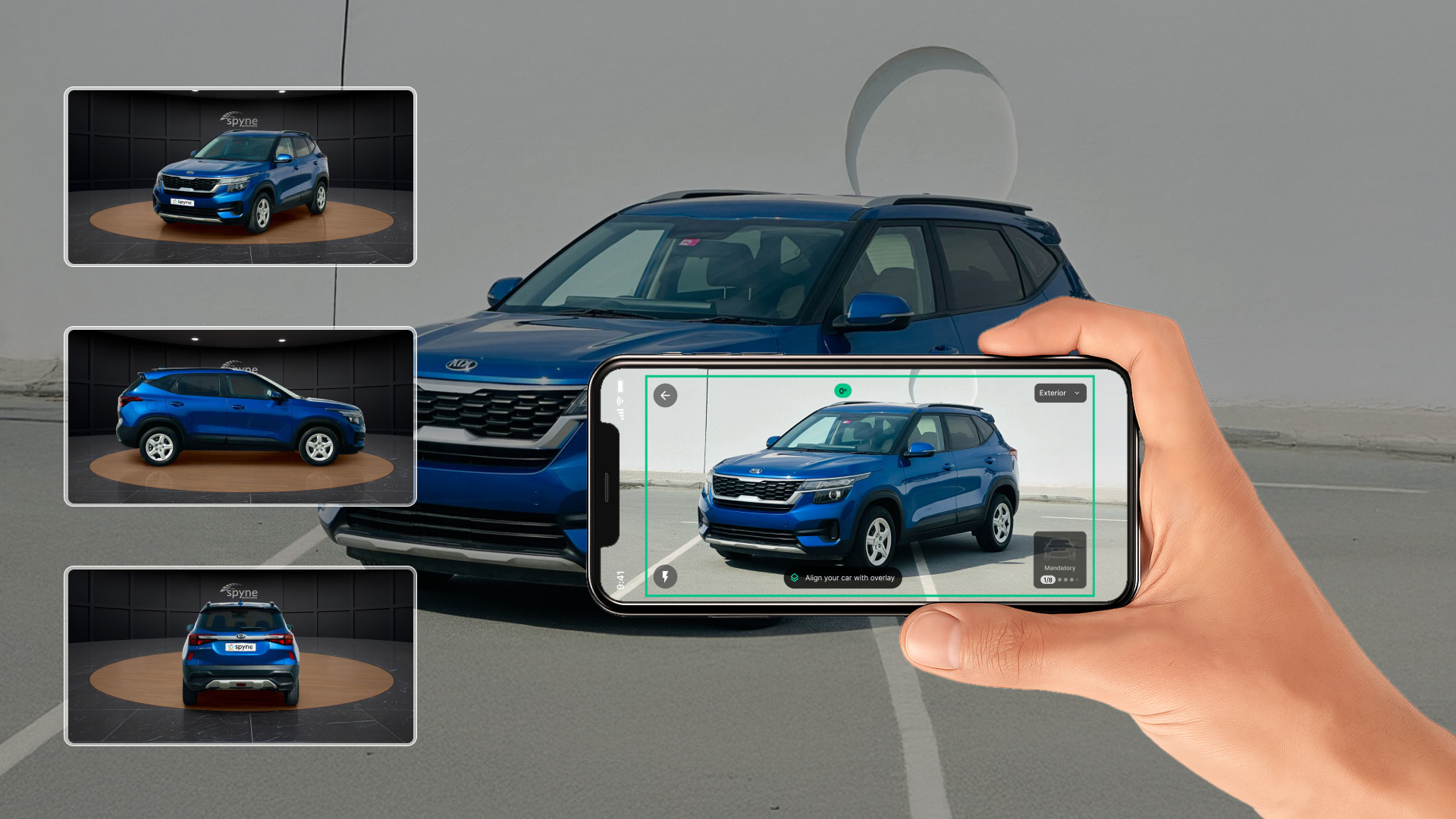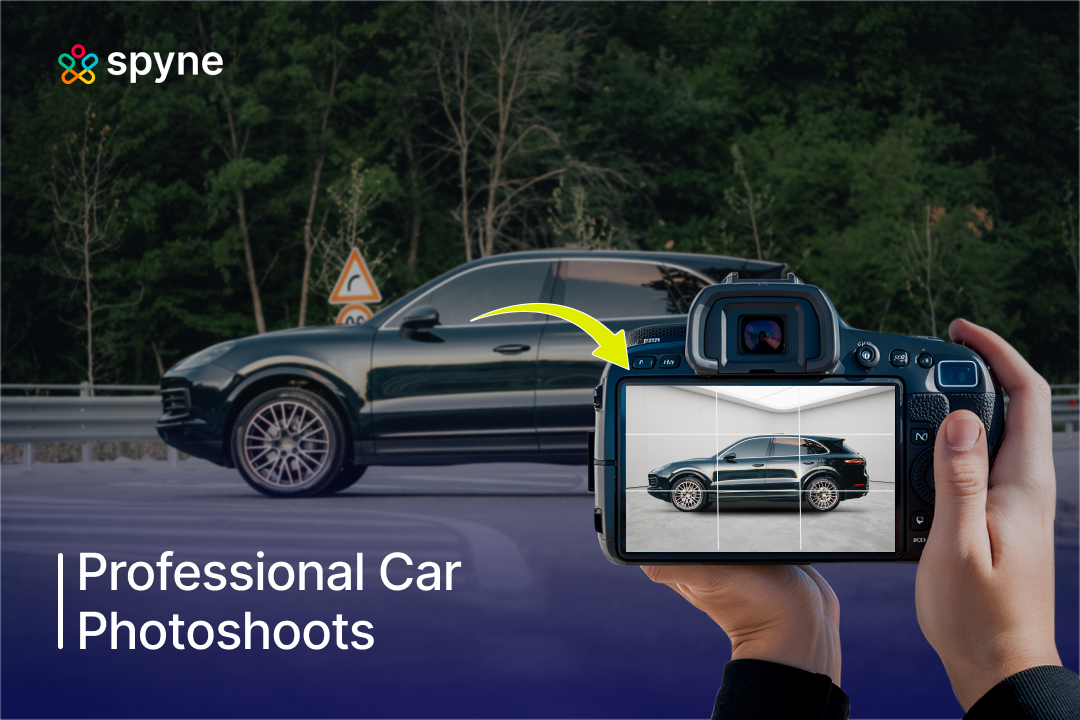Today’s car dealerships have a difficult time standing out as consumers search through car listings on the internet more quickly than ever before. For example, a visitor might spot a crossover on a dealer’s website, but if the photos are dull or imperfect, they quickly move on.
Moreover, 90% of car buyers begin their search online, and blurry photos in dim lighting or against cluttered backgrounds turn many away. While competitors with eye-catching pictures attract customers and increase sales, dealerships stuck with subpar vehicle images watch cars collect dust on the lot.
Customers quickly sort through the many options available on the internet. Therefore, when dealers get the car photoshoot right, listings attract more visitors and sales climb faster. In this online-driven game, clear, good-quality car visuals are no longer a good-to-have but critical for closing car deals today.
What is a Car Photoshoot?
A car photoshoot puts a vehicle in the spotlight and makes it pop like the hero of its own story. Instead of some rapid click with whatever camera is handy, a car photoshoot is set up carefully by experts who place the car under just the right glow. They capture the shots from all angles and highlight what makes the car stand out.
For instance, during the photoshoot, photographers focus on stylish contours or cozy interiors. Photographers can even create a 360-degree spin view so viewers can see it without stepping out from their screens. Professionals further edit such high-resolution images to ensure that they appear flawlessly on dealer sites, applications, and marketplaces, which immediately attract browsers’ attention.
The Importance of High-Quality Visuals in Automotive Retail

What dealerships once saw as optional has become a vital strategy for digital success. Without question, stunning vehicle images drive modern car sales. A COX Automotive study shows 40% of shoppers buy based solely on online visuals. Consequently, professional car images help dealers build trust and spark demand, leading to more inquiries.
Dealerships embracing this shift notice clear results. High-quality photos reflect the business’s professionalism, speeding up the car-buying journey from browse to purchase.
How to Get a Professional Car Photoshoot for Your Dealership?
Getting those pro-grade photographs for a dealer’s portfolio can be smooth and effective with a clear plan. Here’s how dealerships can make it happen without disrupting their daily operations:
-
Sort Your Stock First: Start with vehicles needing a boost, like new arrivals or slow-movers past a month. This targets cars that drive sales or clear space.
-
Choose the Right Partner or Setup: For smaller lots, hire an experienced automotive photographer; for larger ones, set up an in-house system. Pros bring expertise, while in-house offers control for high-turnover dealers.
-
Prepare the Vehicle Thoroughly: Wash, polish, and shine tires to make the car gleam. Remove distractions like keychains to keep focus on the vehicle’s features.
-
Choose the Right Spot: Shoot outdoors at dawn or dusk for warm light, or use indoor lamps to avoid weather issues. The right setting enhances colors and cuts clutter.
-
Shoot Smart and Steady: Direct the car to precise spots, capturing 20-30 shots, including three-quarter views, side profiles, and interiors. A tripod ensures clarity, and quick bursts cover angles fast.
-
Edit and Publish Fast: Edit images for clarity, adjusting light, balancing colors, and swapping backgrounds for branded ones. Get them live on your site or app quickly to hook buyers.
For dealers short on time, outsourcing to specialists who include videos with photos delivers fresh visuals fast. It keeps operations smooth and drives clicks and inquiries.
Essential Equipment for Professional Car Photography
Capturing a car’s true spark requires gear that’s sturdy and ready for the fast pace of dealer life. Here’s what car photography equipment you need to click shots that sell:
- Heavy-Duty Camera: A full-frame DSLR or mirrorless captures every patch of paint and stitch of upholstery and is the best camera for car photos. These cameras handle dim light and fine details, outclassing phone cameras with their pro-level clarity.
- Flexible 24-70mm Lens: This lens frames the car’s full shape without weird bends, and is perfect for wide shots that pull viewers in. It’s a go-to for shooting vehicles that look bold yet real.
- Durable Stands: A sturdy tripod locks in sharp, repeatable angles for batch shoots. A lighter monopod allows you to move fast around cars and keep shoots efficient on busy days.
- Lighting That Pops: Get portable LED panels or softboxes with 5000K glow to smooth out shadows and highlight curves. Reflectors cut glare on glass and ensure the windshield and chrome shine without too many distractions.
- Wireless Trigger and Spare Batteries: A remote trigger prevents shakes for focused shots, and extra batteries keep the shoot ongoing through long hauls across the lot.
This car photoshoot equipment setup enables dealers to match studio vibes. Additionally, training staff on these tools creates a steady stream of visuals that move inventory faster.
Proven Car Photoshoot Strategies That Sell Cars Faster
Turning car photos into deal-closers requires dealerships to adopt smart practices with quick moves, all aimed at driving sales.
Here are a few car photoshoot tips to make every shot a deal-maker:
-
Prepare Like It’s Showtime: Polish the car to a mirror shine and shoot in soft morning light or shaded spots. This keeps colors true and curves glowing.
-
Mix Up the Angles: Hit front-side angles for appeal, low shots for bold vibes, and high ones for sleek curves. Capture 10-15 frames per car, zooming on wheels, sunroofs, or dashboards to highlight unique features.
-
Keep It Uniform: Match backgrounds and edit styles for a cohesive brand look. This builds trust, making your digital lot professional, not random.
-
Add 360 Spins or Video Clips: Shoot full-circle views or create short car videos for a walkaround feel, tripling clicks. These spark urgency and engagement.
-
Edit Smart and Test on Mobile: Boost vibrancy without overdoing it and test on phones for small-screen appeal. Subtle tweaks keep images authentic.
-
Track and Tweak Results: Monitor views-to-calls to spot winners. Dealers using these steps see more leads, higher margins, and less lot time.
Beyond some basic tricks, these are proven tips for car photography that make car visuals appealing, turning browsers into buyers and keeping stock moving.
How Spyne Helps Dealerships Get Studio-Quality Car Photoshoots at Scale?

Spyne’s Virtual Car Studio revamps how dealers turn substandard car photos into professionally crafted images that drive sales. Teams can click quick shots through mobile phones and upload them to the platform. Spyne’s virtual car studio uses AI tools to enhance images and eliminates the need for traditional photoshoots.
Here’s how its features improve basic car pictures into studio-quality images that sell cars quicker:
- AI-Powered Image Editing: It supports AI-powered image editing that sharpens details and fixes lighting, turning poorly clicked shots into clear visuals that grab buyers’ attention quickly.
- Background Replacement: Spyne’s background replacement swaps messy backgrounds for clean backdrops, making cars look premium and boosting listing appeal.
- 360-Degree Spins: The 360-degree spin feature creates interactive rotations that enable buyers to explore each car completely, building trust and speeding their decisions.
- Car Video Maker: The car video maker feature turns still pictures into short video clips, adding motion to listings for higher clicks and inquiries.
- Number Plate Blur: Dealerships can use number plate blur to hide number plates and add their logos, ensuring privacy and simultaneously improving branding to strengthen buyer confidence.
- Car Color Changer: The car color changer feature shows custom color options, exciting buyers to visualize their ride and act quickly.
- API Bulk Processing: Auto-edits dealers’ complete inventories, saving their time for fresh listings coming in and keeping stock moving.
These features make Virtual Car Studio an all-in-one solution, delivering studio-quality photos at scale.
Conclusion
In the high-stakes world of car sales, professional photoshoots are the hidden force pulling in inquiries, slashing lot times, and building buyer trust. High-quality car visuals make inventory pop, with top dealers seeing cars sell faster. To achieve high ROI, dealers should audit their current images for improvement scope, then invest in a car photoshoot using best-quality equipment and smart photography strategies.
Platforms like Spyne simplify this grind for dealerships by delivering studio-grade car photographs without hassle. Book a demo today to see the difference in action. In this digital-first market, clean, attractive car images go beyond looks and are the key to bringing in more site visitors, closing car sales quickly, and keeping inventory moving.
FAQs
1. Why do professional car photoshoots matter for dealerships?
Clear, high-quality car photos grab 118% more views and sell cars faster by showcasing quality, building buyer trust, and sparking urgency in online listings.
2. What makes a car photoshoot different from regular photos?
It’s a pro setup with expert lighting, varied angles, and edits that highlight a car’s unique features, unlike quick, sloppy snaps clicked by phone.
3. How can dealerships start with professional car photoshoots?
- Select and prioritize high-priority cars (newly-added or slow-movers).
- Hire a professional photographer or set up an in-house setting.
- Prepare vehicles, shoot in good light, make edits, and post online.
4. How do high-quality visuals boost car sales?
Professional studio-quality car photographs reflect dealership credibility. Today, when 40% of buyers are ready to commit based on images alone, high-quality visuals boost clicks and drive inquiries.
5. What are the best tips for a successful car photoshoot?
- Wash and polish cars to enhance their shine, and shoot in soft light.
- Use varied angles (10-15 shots) and 360 spins.
- Keep backgrounds uniform and test on mobile screens.
6. How does Spyne’s Virtual Car Studio help dealers with car photoshoots?
Spyne’s AI enhances random car clicks with features like background swaps, 360 spins, and color changes, boosting inquiries with minimal effort.
7. Can car dealerships scale photography without a big budget?
Yes, car dealers can use Spyne’s API for bulk editing or train staff on a basic car photoshoot setup to generate studio-quality visuals that keep their inventory moving.







